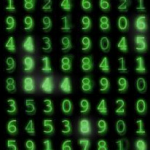
Numbers
Numbers – a concept conceived by mankind for the purpose of representing quantity, formulating equations, and translating many natural objects, occurrences and phenomena so our advanced minds can comprehend and understand them. They’re also what make games awesome.
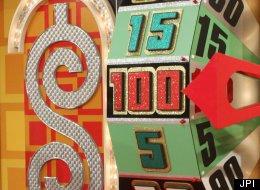 My fascination with numbers originated from a fairly young age, when I was introduced to the amazing and still-running game show, The Price Is Right. I could have watched any educational show at the time (of which I don’t really think there were many, now that I think about it) that could have taught me numbers and how they work, but nope, it was Bob Barker. I owe that show a lot, because when it comes to video games, numbers are everything.
My fascination with numbers originated from a fairly young age, when I was introduced to the amazing and still-running game show, The Price Is Right. I could have watched any educational show at the time (of which I don’t really think there were many, now that I think about it) that could have taught me numbers and how they work, but nope, it was Bob Barker. I owe that show a lot, because when it comes to video games, numbers are everything.
You might not realize that on the surface, but think about it. The most obvious implementation of numbers in games, as far as I’m concerned, is score. You get a higher score than your opponent, then you win, or you can rank your score on a list. Ranks also comprise of numbers, usually 1-10 in arcade games, but modern leaderboards go as far as there are players. Score is such a core component of games, it’s the primary link to sports (which are also games, as far as I’m concerned). And speaking of sports, fantasy football, which is about as fake a sport or game as you can get, also heavily involve numbers.
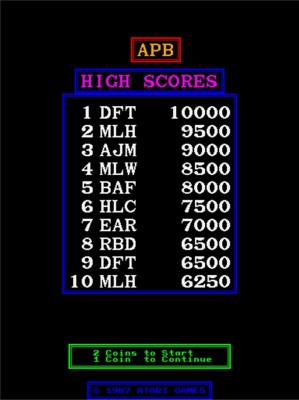 If score isn’t the first thing you think of, then maybe it’s the code. It doesn’t matter what programming language you use, everything boils down to 1s and 0s. Even hexidecimal is reduced to numbers – it uses the letters A through F, but it uses them as representations of 11-16. Or, if it wasn’t code, maybe it was the logistics of the gaming industry. Sales numbers, production costs, and retail price, all numerical. How about journalism? Top 10 lists, game review scores, and as much as I dislike Metacritic, it too is draped in numbers.
If score isn’t the first thing you think of, then maybe it’s the code. It doesn’t matter what programming language you use, everything boils down to 1s and 0s. Even hexidecimal is reduced to numbers – it uses the letters A through F, but it uses them as representations of 11-16. Or, if it wasn’t code, maybe it was the logistics of the gaming industry. Sales numbers, production costs, and retail price, all numerical. How about journalism? Top 10 lists, game review scores, and as much as I dislike Metacritic, it too is draped in numbers.
As a designer, however, numbers are truly awesome. You might not think about it much during gameplay, but without realizing it, numbers make up virtually every part of a game. Let’s take a simple game like Super Mario Bros for example. How many hits is Mario allowed to take before he dies? How many lives does the player get to start with? What do coins do? How many levels are there in the game? How many worlds? What’s the reward for reaching higher points of the flagpole? How many hits does a goomba take before it dies? A koopa troopa? A buzzy beetle? Bowser? How high is Mario allowed to jump? How fast is Mario allowed to run? How much higher can Mario jump while he’s running? How much time do you get to complete each level. All of these questions can be answered with numbers (some being a “depends,” but still), and all are variable by the designer (or at least they were during development).
What about a multiplayer game, using Team Fortress 2 as an example? The Scout can run faster than any other class, but has fewer hit points. Meanwhile, Heavy Weapons Guy is the slowest class, but also the one with the most HP. The reason is balance, and the balance is shown through numbers. The Soldier class has a powerful rocket launcher, but takes time to reload (in seconds – numbers). Similarly, the Spy can turn invisible, but only for a certain amount of time. With the right item, that time can be infinity – which isn’t even a real number, but numbers aren’t real anyway, so get over it. Speaking of items, the game has many that you can use in place of others, but they have distinct tradeoffs. Would you rather have a rocket launcher that has 4 rockets per load, or 3, but you regain lost HP when you hit an opponent? What about one that shoots faster rockets, but deals less damage? Not only are you having to deal with tradeoffs, but so are your opponents – the real art of Team Fortress 2 and games like is that it’s a matter of understanding what situations to utilize your upsides against your opponents or to avoid them because of your downsides, all of which are created by numbers.
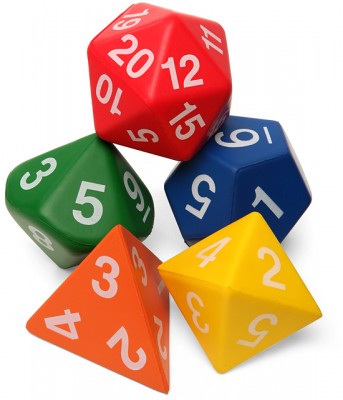 Lastly, let’s look at the genre that probably uses numbers the most – RPGs. Dungeons & Dragons isn’t even a video game, but it’s a great example and one that most RPGs are (often directly) rooted to. Since it’s a role-playing game, you play a role as portrayed by a character in the game. Said character has six distinct abilities – strength, dexterity, constitution, intelligence, wisdom, and charisma – and all of these are represented with numbers. The higher the number(s), the better you are at certain activities. A character with high charisma is more persuasive and likable, while a character with high constitution has more hit points and is less susceptible to disease and negative spell effects. And virtually all actions are determined by rolling dice.
Lastly, let’s look at the genre that probably uses numbers the most – RPGs. Dungeons & Dragons isn’t even a video game, but it’s a great example and one that most RPGs are (often directly) rooted to. Since it’s a role-playing game, you play a role as portrayed by a character in the game. Said character has six distinct abilities – strength, dexterity, constitution, intelligence, wisdom, and charisma – and all of these are represented with numbers. The higher the number(s), the better you are at certain activities. A character with high charisma is more persuasive and likable, while a character with high constitution has more hit points and is less susceptible to disease and negative spell effects. And virtually all actions are determined by rolling dice.
For example, hitting someone with a large heavy mace deals 2d6 damage. What that means is you roll two six-sided dice and add them up. If your character is strong, they get a bonus, so if your character has 16 strength, you deal an additional 2 damage, and if they attacked someone using said heavy mace, it would deal 2d6+2, or anywhere from 4 to 14 damage, depending on dice results. I haven’t even scratched the surface when it comes to numbers in D&D – saving throws, checks, leveling up, just about every aspect of D&D uses numbers, and for a game that’s not a video game, I think it’s pretty intuitive.
My only beef with numbers is that sometimes developers feel it’s necessary to use insanely high numbers. To demonstrate how high these numbers are, let’s look at some RPGs in order of their general number scale. Magic The Gathering might not be an RPG, but it does have some awesome numerical concepts I’m saving for another article, and it does have many similarities with RPG combat. Considering the strongest creatures in that game without buffs has 15 toughness (kind of like HP), it’s the lowest on this scale. Paper Mario would come next, followed by Pokemon, then Dragon Quest, then Chrono Trigger. All these games use triple digits at the most, and this, to me, is the butterzone of numbers in games. Torchlight, most JRPGs, and later Final Fantasy games would come next, delving into quadruple digits, but still being manageable.
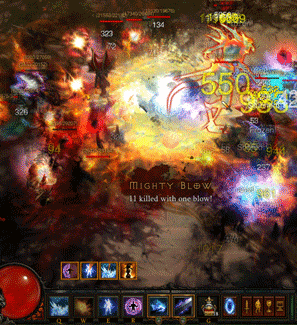 I think when a game hits 5-digits, it starts to meander to into “why are we using such high numbers” territory. Enter World of Warcraft. When it came out, characters at max level had 4-digit max HP and dealt similar damage. It then tipped into 5-digit, but now, it’s up to 6. 6 digits of damage. What’s the nuance between dealing 162,492 damage and dealing 162,473? Not much, as at that point 21 damage is miniscule. In Magic The Gathering, 21 damage is more than enough to win the game under normal circumstances. And if you think that’s insane, you should see Diablo 3. With the new expansion, players are dealing 6-digit numbers normally, and are going into 7-digit numbers. Someone on Youtube managed to deal a critical hit that did nearly a billion damage. A billion. Nine digits. At least round it up and show something like “659k” on the damage indicators, but come on. Not to mention Diablo 3, and WoW for that matter, have a problem with too many things being hit for damage numbers to even matter much anymore. 3 digits should be adequate for most games, and if you go past 4 digits, your game has serious pacing and scaling issues.
I think when a game hits 5-digits, it starts to meander to into “why are we using such high numbers” territory. Enter World of Warcraft. When it came out, characters at max level had 4-digit max HP and dealt similar damage. It then tipped into 5-digit, but now, it’s up to 6. 6 digits of damage. What’s the nuance between dealing 162,492 damage and dealing 162,473? Not much, as at that point 21 damage is miniscule. In Magic The Gathering, 21 damage is more than enough to win the game under normal circumstances. And if you think that’s insane, you should see Diablo 3. With the new expansion, players are dealing 6-digit numbers normally, and are going into 7-digit numbers. Someone on Youtube managed to deal a critical hit that did nearly a billion damage. A billion. Nine digits. At least round it up and show something like “659k” on the damage indicators, but come on. Not to mention Diablo 3, and WoW for that matter, have a problem with too many things being hit for damage numbers to even matter much anymore. 3 digits should be adequate for most games, and if you go past 4 digits, your game has serious pacing and scaling issues.
Anyway, numbers are pretty vital to gaming. I believe anyone who likes numbers and math should at least like playing with numbers, which is what a lot of games, especially board games, really are. Playing with numbers. Oh, and that list bit was, eh, “inspired” by this bit from Penn & Teller’s Bullshit. I think Penn describes these insane numbers and why they suck better than I can, and I believe that holds true for games as well. But don’t watch if you’re offended by foul words, like bullshit.
Categories: Features
0 Comments
This post has been left all alone with no comments. Don't leave it lonesome - give it some company with a comment.